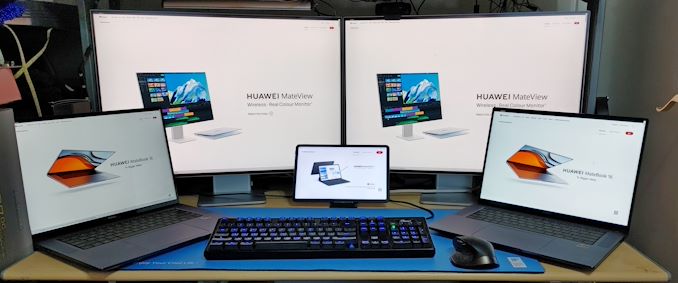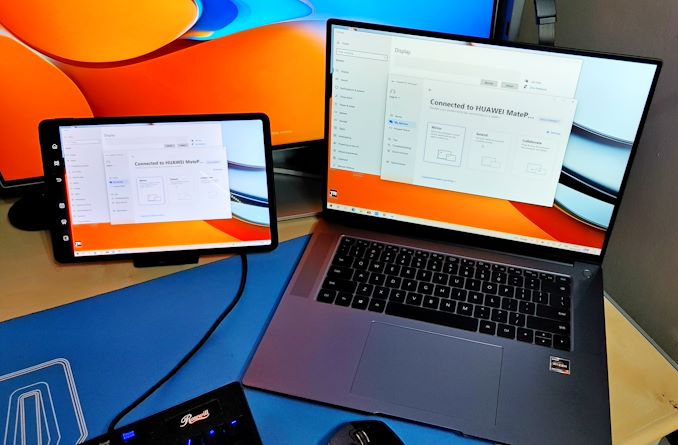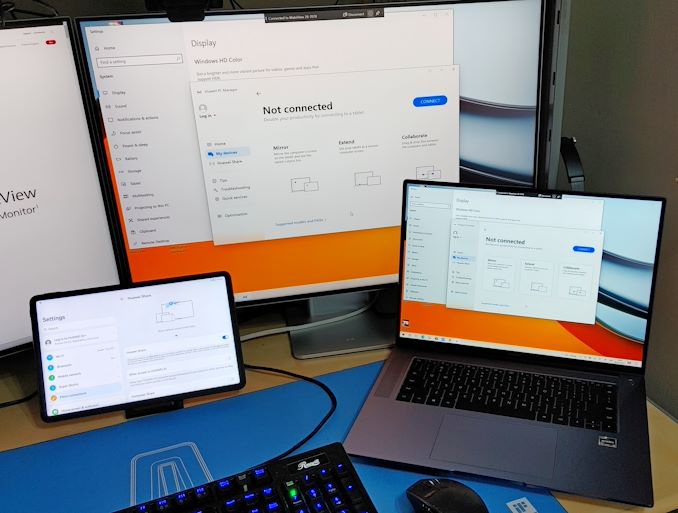The Huawei MateBook 16 Review, Powered by AMD Ryzen 7 5800H: Ecosystem Plus
by Dr. Ian Cutress on October 20, 2021 8:00 AM EST- Posted in
- Laptops
- AMD
- Huawei
- Matebook
- Ryzen
- Zen 3
- MateBook 16
- Huawei Share
- Ryzen 7 5800H
Huawei Share
For the last few generations, the Huawei Share utility was advertised as an easy way to transfer files between a Huawei smartphone and a Huawei laptop. By using the NFC sensor in the phone, and an NFC coil on the right side of the trackpad, a user could ideally wave their smartphone, and the requisite app would load on both devices asking to connect. This functionality eventually expanded to allow the smartphone display to show on the laptop, or the smartphone to be used as an additional touch screen/mouse control for the laptop.
That’s about where it stood before the company was put on the US Entity list. Since then, the opportunity to test the feature’s improvements has been few and far between, partly due to the confusion about where and when devices would come out, but also the global pandemic limited travel, product launches, and demonstrations. Fast forward to 2021, and Huawei’s device portfolio has expanded.
The most notable expansion in my eyes is a push into the monitor market. Huawei now sells two monitors: the MateView, a 28-inch HDR400 monitor at a 3:2 aspect ratio labeled as a 4K+ resolution (3840x2560), and the MateView GT, a 34-inch ultrawide monitor with a 3440x1440 resolution and 165 Hz refresh rate. Both monitors also feature an NFC coil in the base to use with Huawei Share, as well as an intuitive menu system to support wireless connectivity with any non-Huawei supporting device. The MateView displays were recently significantly discounted in the UK over September (£400 after rebate), and unbeknownst to the Huawei PR team here, I purchased two.
The PR team had sent over the latest Huawei Android Tablet, the MatePad 11, to test with Huawei Share. Put this all together, with my Huawei P30 Pro smartphone, and technically everything should work with everything else.
Connecting the laptop to either the smartphone or the tablet works through Huawei Share directly. The tablet allows for screen duplicate, screen expansion, or using the tablet as a mouse for the laptop. Connecting the smartphone shows the smartphone screen on the laptop, so it can be controlled with a mouse/keyboard, as well as take calls and tether to take advantage of any data/Wi-Fi. The laptop control of the smartphone allows for multiple smartphone apps to be open in separate windows, including video playback on YouTube, for example, however any audio played on the smartphone is redirected to the laptop instead.
Connecting to the monitor is slightly different, as it doesn’t go through Huawei Share. This is done with Windows’ own wireless display connectivity. Search for ‘connect to a wireless display’, and it goes through the motions. For some devices it requires activating a feature or two inside Windows, but it takes you through it step-by-step, and then after that it’s quite easy. That being said, there is a couple of drawbacks.
Connecting through Huawei Share is secure, and requires verification on both devices. Connecting to the wireless display does not, and so in an open office environment it requires the devices to be named, as you can take over someone’s device even when they are using it. Also, wireless display connectivity at a distance of 6 feet showcased a small but noticeable input lag. In this environment, the display is best for content that doesn’t require much interaction, such as a static calendar, or a film.
But on the plus side, even though Huawei Share is a single point-to-point connection, using the wireless display through Windows option doesn’t take that away, so you can connect to monitor+smartphone or monitor+tablet at the same time. With the HDMI port, there’s another option for a display, perhaps with better input lag as well. Although with all these displays, some being driven through the CPU rather than the GPU, it will start to put a load on the system.
As part of this review process, I ended up with two MateBook 16 devices. The charger on my first one was effectively DoA, so instead of sending me a separate 135W charger, the PR team just sent a full laptop. I was intrigued if I could connect both laptops together – and technically I could through the wireless display feature! While this is really quite pointless, it was a fun activity.
I would say that there is one limitation – I could only connect to one device through Huawei Share at a time. For example, I could not connect to the tablet and the smartphone at the same time – it was one or the other. This is likely down to only having one point-to-point connection available, as more would require battery/cost/weight. Ultimately at some point in Huawei’s future I imagine there to be a dock for multiple devices to be connected to, some wired, others wireless.














87 Comments
View All Comments
EasyListening - Friday, October 22, 2021 - link
You are asking for such a thing while supply chains are completely screwed.GreenReaper - Saturday, October 23, 2021 - link
If you don't ask, you never get.abufrejoval - Wednesday, October 20, 2021 - link
I also see the lack of RAM expandability as the key issue.I have a Lenovo Slim 7 13ACN05 and with all eight cores at 15 Watts it's not really able to pull ahead of a quad core Tiger Lake i7-1165G7 NUC I operate at the same Wattage in 'normal' workloads (say compile jobs, Ansible scripts, juggling VMs etc.), because it needs to downclock too much to sustain the 15 Watt power envelope. It's also maxed out at 16GB for RAM, even a single soldered module seems impossible with an Ultrabook form factor.
64GB in two SO-DIMMs make the NUC quite reasonable machines for light server workloads and I'd sure pay a little extra to include a "KVM", a "UPS" etc. to make it a notebook like this.
At 35-65 Watts an octa Ryzen really pulls ahead of all things Intel quad or hexa in the same wattage rage, but without RAM to expand it's all for naught. With this chassis size replacable RAM should be no issue so it's really sad they go "Apple" there.
While the Tiger Lake Xe 96 EU and Vega 8 iGPUs at 50GB/s offer impressive improvements over plain old "HD", Iris Plus or Kaveri, machine learning and gaming just require completely different classes of hardware, so I'd be happy to sacrifice a bit of DRAM bandwidth and latency for capacity in such a machine.
The Lenovo puts a Windows Hello compatible Webcam in such a small frame on the 16:10 2560x1600 display, I really don't see the point of a snot-cam.
dontlistentome - Wednesday, October 20, 2021 - link
Think yourself lucky you get the option of 16GB, in the UK they only sell the 8GB models.abufrejoval - Thursday, October 21, 2021 - link
I do feel lucky to have the device, because it's generally a well built marvel.But Lenovo is also lucky to have at least offered 16GB, because at 8GB they would have lost that sale for sure.
But I surely would have paid 200% RAM market price for 32 or 64GB.
anandcx - Wednesday, October 20, 2021 - link
@Ian: You missed the LG Gram 16 in comparison, it weighs just 1.19 KG according to LG but i measured my Gram 16 at 1.15 KG. It has 350 nits screen, better keyboard and touchpad and also costs lesser than the 17 inch version. Honestly it is the best laptop in that segment. Hopefully you can review it and it may even work for your personal use.Prestissimo - Wednesday, October 20, 2021 - link
Matebook seems really overpriced for what they're offering. I'll take LG Gram 17 any day over this as someone who doesn't need power and just want a big screen on my laptop for watching movies and consuming content.If a laptop doesn't have a dGPU and weighs over 1.3 kg / 3 lbs, it's an immediate deal breaker. There is no need for a "Premium Ultrabook" to be that heavy.
TheinsanegamerN - Wednesday, October 20, 2021 - link
Big battery is a plenty good reason.anandcx - Wednesday, October 20, 2021 - link
Gram 16 has 80 Wh battery and weighs 1.1 KG. Gram 17 is 1.3 KG.TheinsanegamerN - Wednesday, October 20, 2021 - link
Gram 17 only has a 72wh batteryhttps://www.lg.com/us/laptops/lg-17Z990-RAAS8U1-ul...
Gram 16 has 80wh battery but cannot sustain high performance due to cooling limitations due to small heatsink and cooling paths. May as well compare a tablet to this machine.